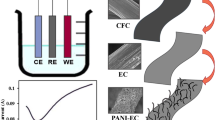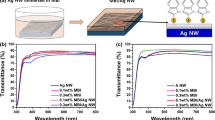Abstract
Polyaniline (PANI) nanowire electrode was successfully prepared using electrodeposition method. The morphology, thickness, and electrochemical performance of PANI electrode can be controlled by varying the deposition scan rates. Lower deposition scan rate results in compact and aggregates of PANI nanowire morphology. The uniform nanowire of PANI was obtained at the applied scan rate of 100 mV s−1, and it was used as symmetric electrode coupled with H2SO4/polyvinyl alcohol (PVA) gel electrolyte. The different concentrations of H2SO4 acid in polymer electrolyte have influenced the electrochemical performance as well. The optimum specific capacitance and energy density of P100 PANI electrode in 3 M H2SO4/PVA gel polymer electrolyte was 377 F g−1 and 95.4 Wh kg−1 at the scan rate of 1 mV s−1. The good stability of the electrode in this system is applicable to many wearable electronics applications.








Similar content being viewed by others
References
Kurra N, Wang R, Alshareef HN (2015) All conducting polymer electrodes for asymmetric solid-state supercapacitors. J Mater Chem A 3:7368–7374
Dirican M, Yanilmaz M, Zhang X (2014) Free-standing polyaniline-porous carbon nanofiber electrodes for symmetric and asymmetric supercapacitors. RSC Adv 4:59427–59435
Ramya R, Sivasubramanian R, Sangaranarayanan MV (2013) Conducting polymers-based electrochemical supercapacitors—progress and prospects. Electrochim Acta 101:109–129
Snook GA, Kao P, Best AS (2011) Conducting-polymer-based supercapacitor devices and electrodes. J Power Sources 196:1–12
Shown I, Ganguly A, Chen L-C, Chen K-H (2015) Conducting polymer-based flexible supercapacitor. Energy Sci Eng 3:2–26
Chen W, Rakhi RB, Alshareef HN (2013) Facile synthesis of polyaniline nanotubes using reactive oxide templates for high energy density pseudocapacitors. J Mater Chem A 1:3315–3324
Meng C, Liu C, Chen L, Hu C, Fan S (2010) Highly flexible and all-solid-state paperlike polymer supercapacitors. Nano Lett 10:4025–4031
Cho S, Shin K-H, Jang J (2013) Enhanced electrochemical performance of highly porous supercapacitor electrodes based on solution processed polyaniline thin films. ACS Appl Mater Interfaces 5:9186–9193
Zhang L, Zhao G, Wang Y (2013) Polyaniline nanowire electrodes with high capacitance synthesized by a simple approach. Mater Sci Eng: C 33:209–212
Li Z, Liu E, Zhu Y, Hu T, Luo Z, Liu T (2015) Enhanced supercapacitive performance of porous activated carbon derived from polyaniline prepared by electrochemical synthesis. Mater Res Bull 64:6–11
Xin G, Wang Y, Liu X, Zhang J, Wang Y, Huang J, Zang J (2015) Preparation of self-supporting graphene on flexible graphite sheet and electrodeposition of polyaniline for supercapacitor. Electrochim Acta 167:254–261
Bonastre AM, Bartlett PN (2010) Electrodeposition of PANi films on platinum needle type microelectrodes. Application to the oxidation of ascorbate in human plasma. Anal Chim Acta 676:1–8
Stoller MD, Ruoff RS (2010) Best practice methods for determining an electrode material’s performance for ultracapacitors. Energy Environ Sci 3:1294–1301
Li H, Wang J, Chu Q, Wang Z, Zhang F, Wang S (2009) Theoretical and experimental specific capacitance of polyaniline in sulfuric acid. J Power Sources 190:578–586
Focke WW, Wnek GE, Wei Y (1987) Influence of oxidation state, pH, and counterion on the conductivity of polyaniline. J Phys Chem 91:5813–5818
Zhao G-Y, Li H-L (2008) Preparation of polyaniline nanowire arrayed electrodes for electrochemical supercapacitors. Micropor Mesopor Mat 110:590–594
Li G-R, Feng Z-P, Zhong J-H, Wang Z-L, Tong Y-X (2010) Electrochemical synthesis of polyaniline nanobelts with predominant electrochemical performances. Macromolecules 43:2178–2183
Rusi MSR (2013) Synthesis of MnO2 particles under slow cooling process and their capacitive performances. Mater Lett 108:69–71
Pereira VR, Isloor AM, Bhat UK, Ismail AF (2014) Preparation and antifouling properties of PVDF ultrafiltration membranes with polyaniline (PANI) nanofibers and hydrolysed PSMA (H-PSMA) as additives. Desalination 351:220–227
Abdolahi A, Hamzah E, Ibrahim Z, Hashim S (2012) Synthesis of uniform polyaniline nanofibers through interfacial polymerization. Materials 5:1487
Rakhi RB, Chen W, Cha D, Alshareef HN (2012) Nanostructured ternary electrodes for energy-storage applications. Adv Energy Mater 2:381–389
Zhang YX, Huang M, Li F, Wang XL, Wen ZQ (2014) One-pot synthesis of hierarchical MnO2-modified diatomites for electrochemical capacitor electrodes. J Power Sources 246:449–456
Chen Y, Wang J-W, Shi X-C, Chen B-Z (2013) Pseudocapacitive characteristics of manganese oxide anodized from manganese coating electrodeposited from aqueous solution. Electrochim Acta 109:678–683
Yang W, Gao Z, Song N, Zhang Y, Yang Y, Wang J (2014) Synthesis of hollow polyaniline nano-capsules and their supercapacitor application. J Power Sources 272:915–921
Wang D-W, Li F, Zhao J, Ren W, Chen Z-G, Tan J, Z-S W, Gentle I, GQ L, Cheng H-M (2009) Fabrication of graphene/polyaniline composite paper via in situ anodic electropolymerization for high-performance flexible electrode. ACS Nano 3:1745–1752
Rusi MSR (2014) High performance super-capacitive behaviour of deposited manganese oxide/nickel oxide binary electrode system. Electrochim Acta 138:1–8
Sawangphruk M, Kaewsongpol T (2012) Direct electrodeposition and superior pseudocapacitive property of ultrahigh porous silver-incorporated polyaniline films. Mater Lett 87:142–145
Ramesh TN, Kamath PV (2008) Nickel oxyhydroxide/manganese dioxide composite as a candidate electrode material for alkaline secondary cells. J Power Sources 175:625–629
Zhang M, Guo S, Zheng L, Zhang G, Hao Z, Kang L, Liu Z-H (2013) Preparation of NiMn2O4 with large specific surface area from an epoxide-driven sol−gel process and its capacitance. Electrochim Acta 87:546–553
Acknowledgments
We would like to thank the University of Malaya (grant nos. FP008-2013B and RP025 B-14AFR) for financial support. Rusi appreciate the Skim Bright Sparks University Malaya (SBSUM) for the scholarship awarded.
Author information
Authors and Affiliations
Corresponding author
Rights and permissions
About this article
Cite this article
Rusi, Sim, CK. & Majid, S.R. Morphology-controlled PANI nanowire electrode by using deposition scan rate in H2SO4/PVA polymer electrolyte for electrochemical capacitor. Ionics 23, 1219–1227 (2017). https://doi.org/10.1007/s11581-016-1938-0
Received:
Revised:
Accepted:
Published:
Issue Date:
DOI: https://doi.org/10.1007/s11581-016-1938-0




